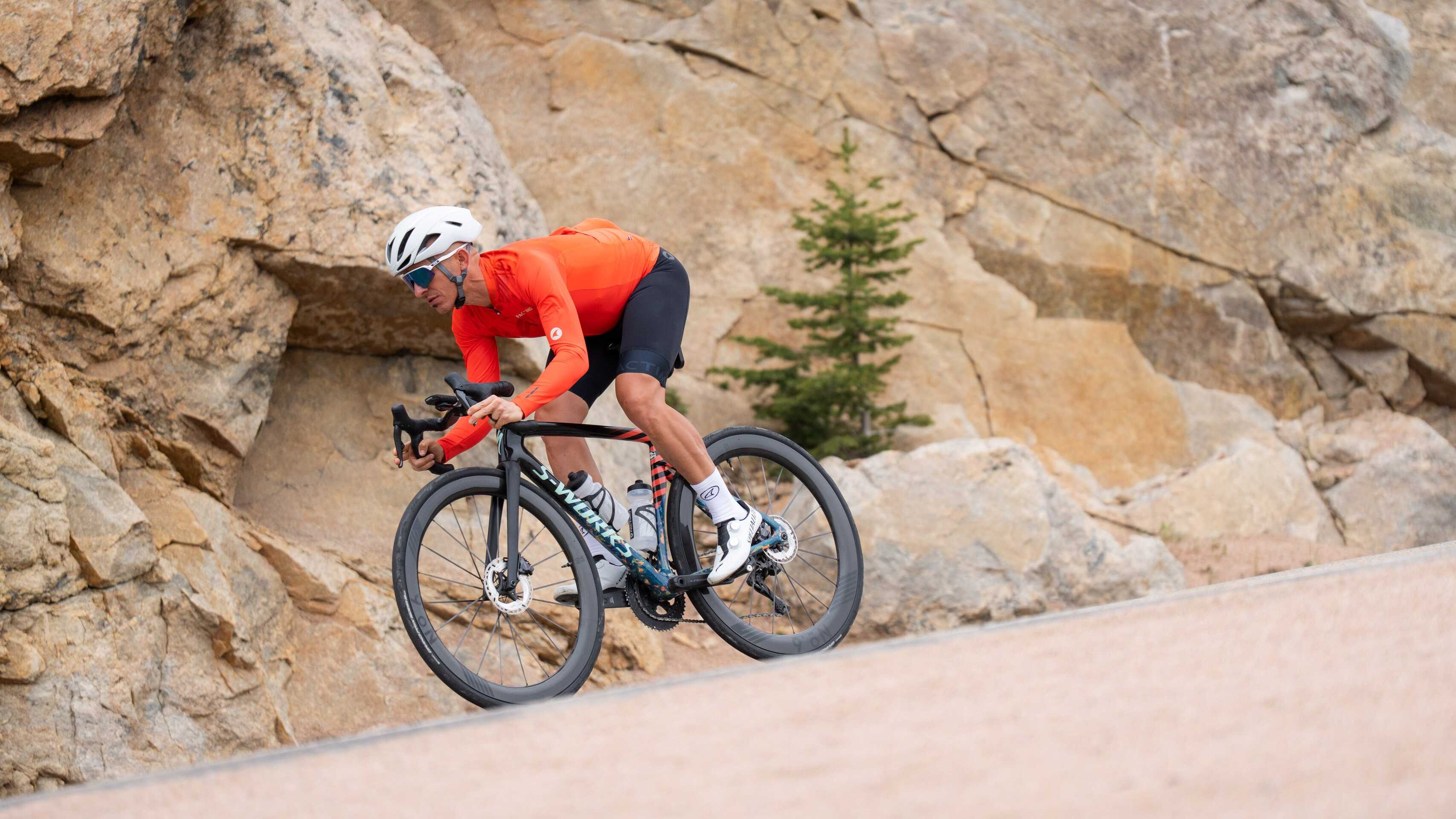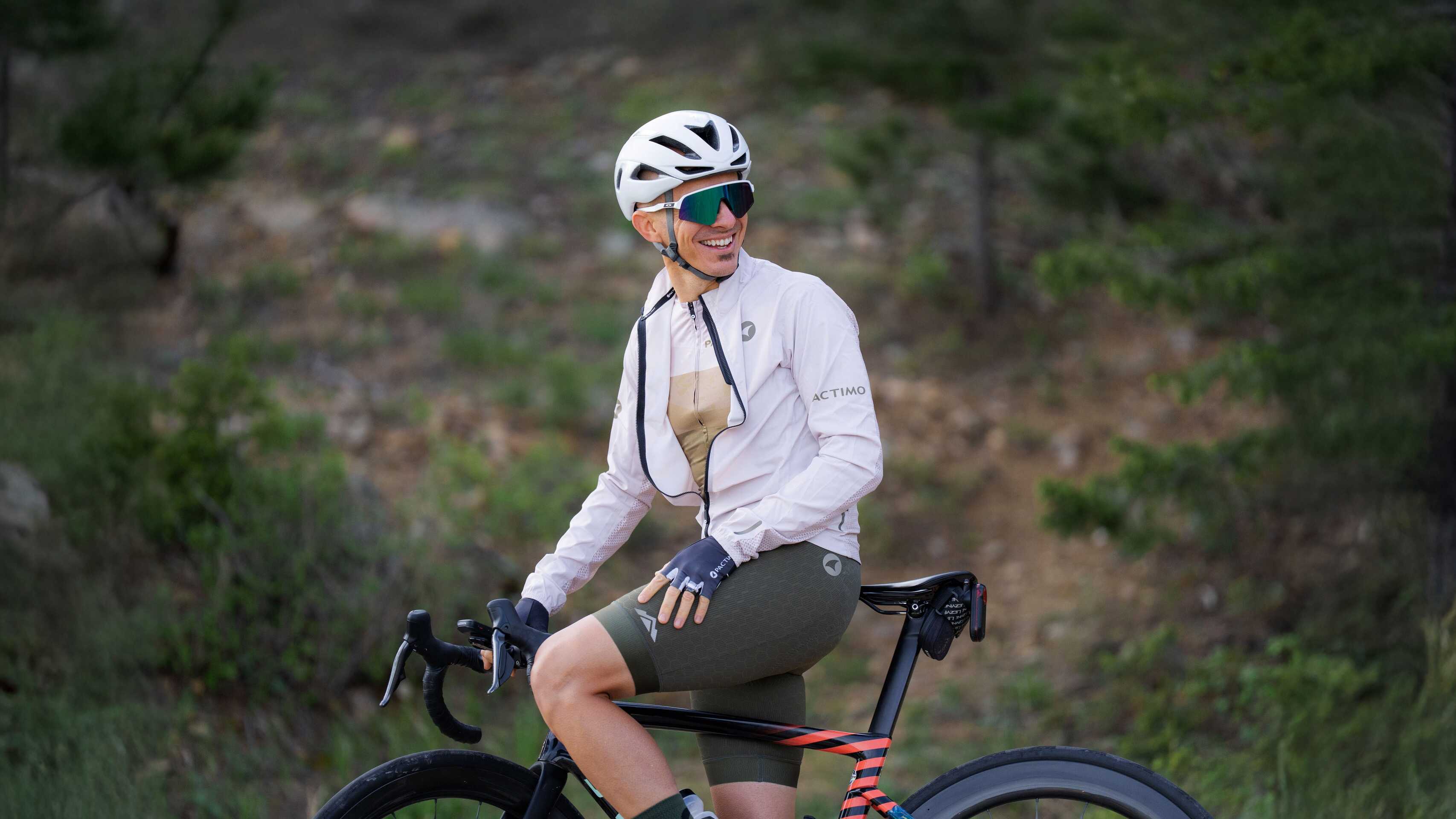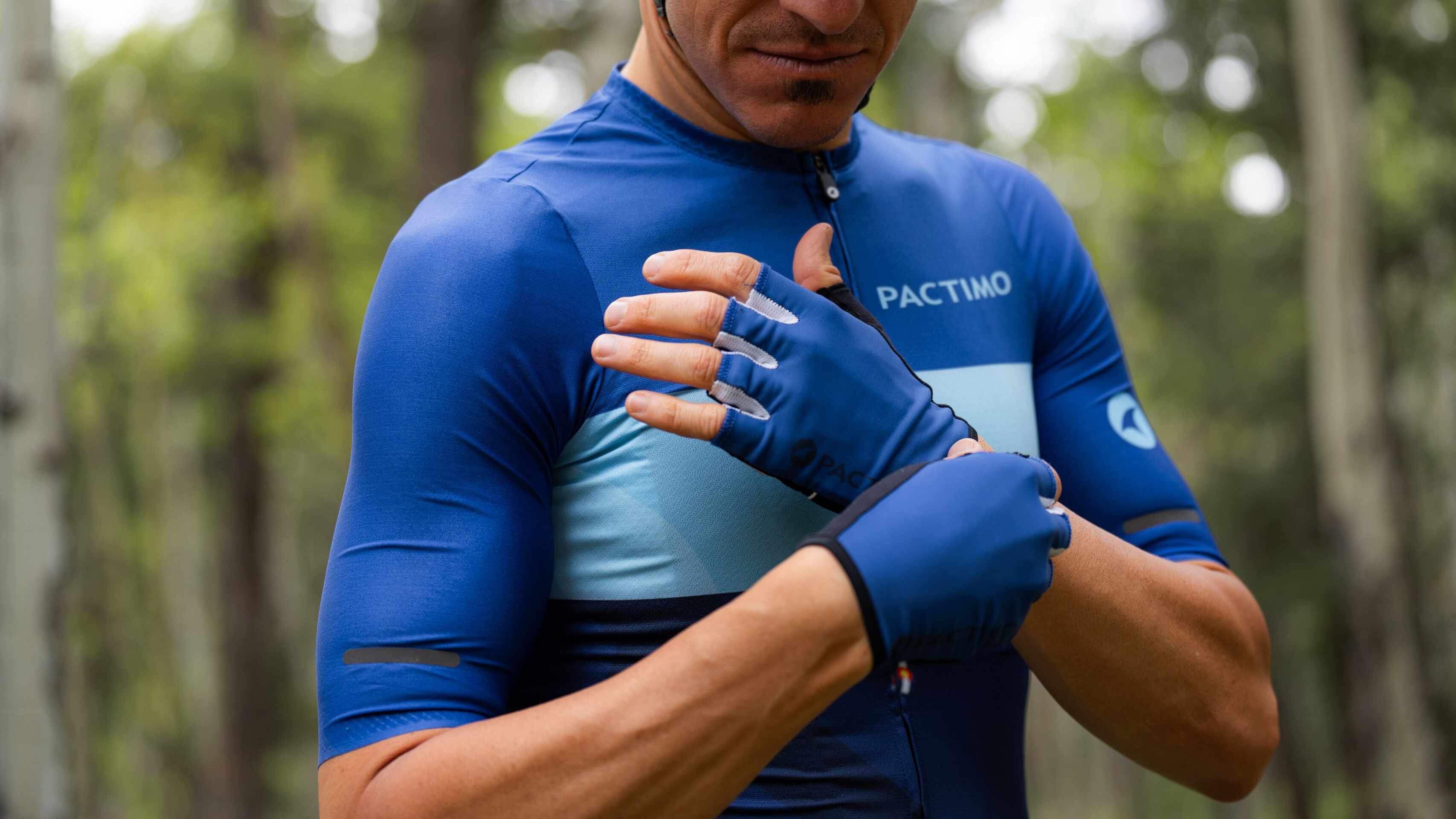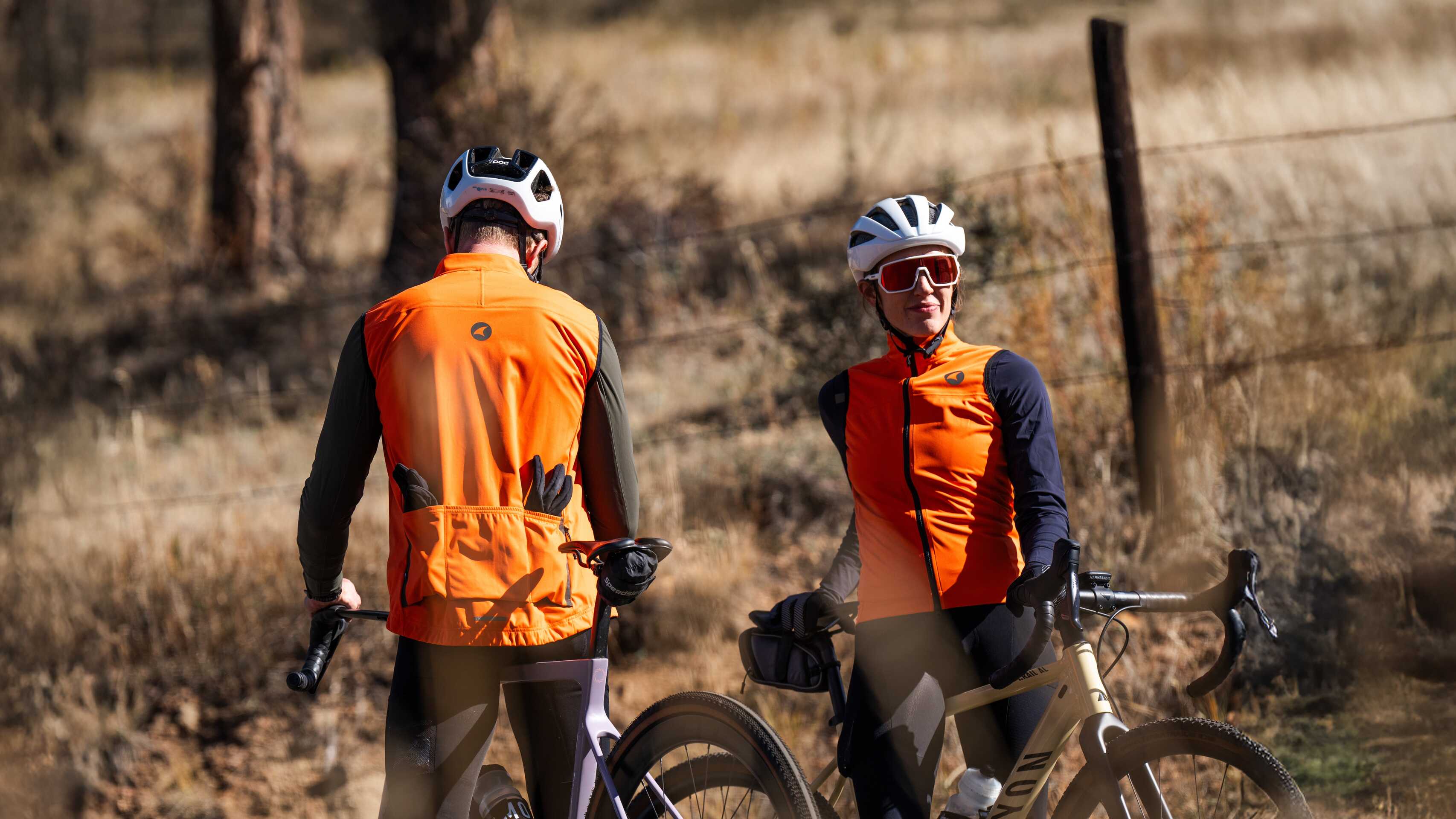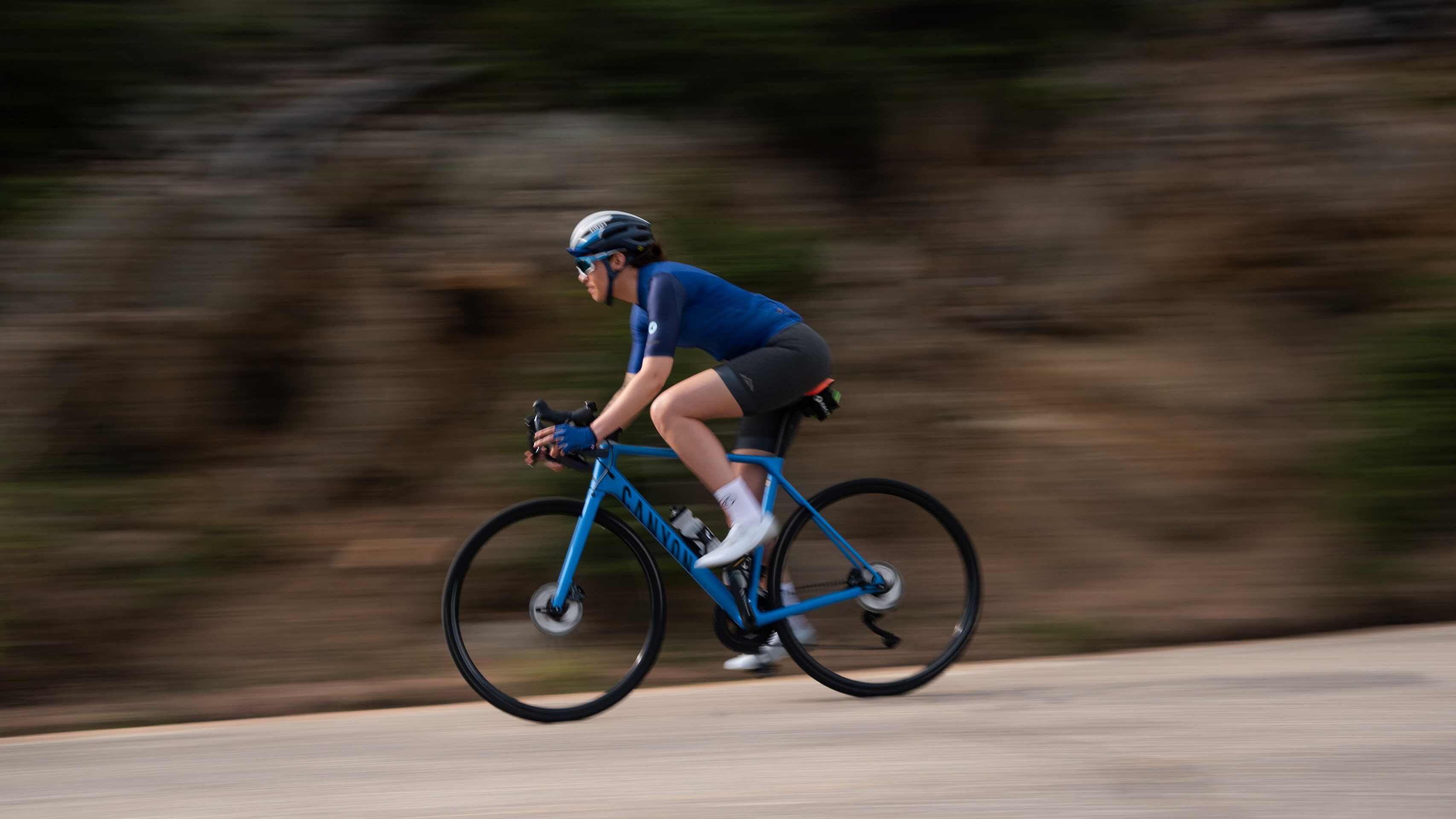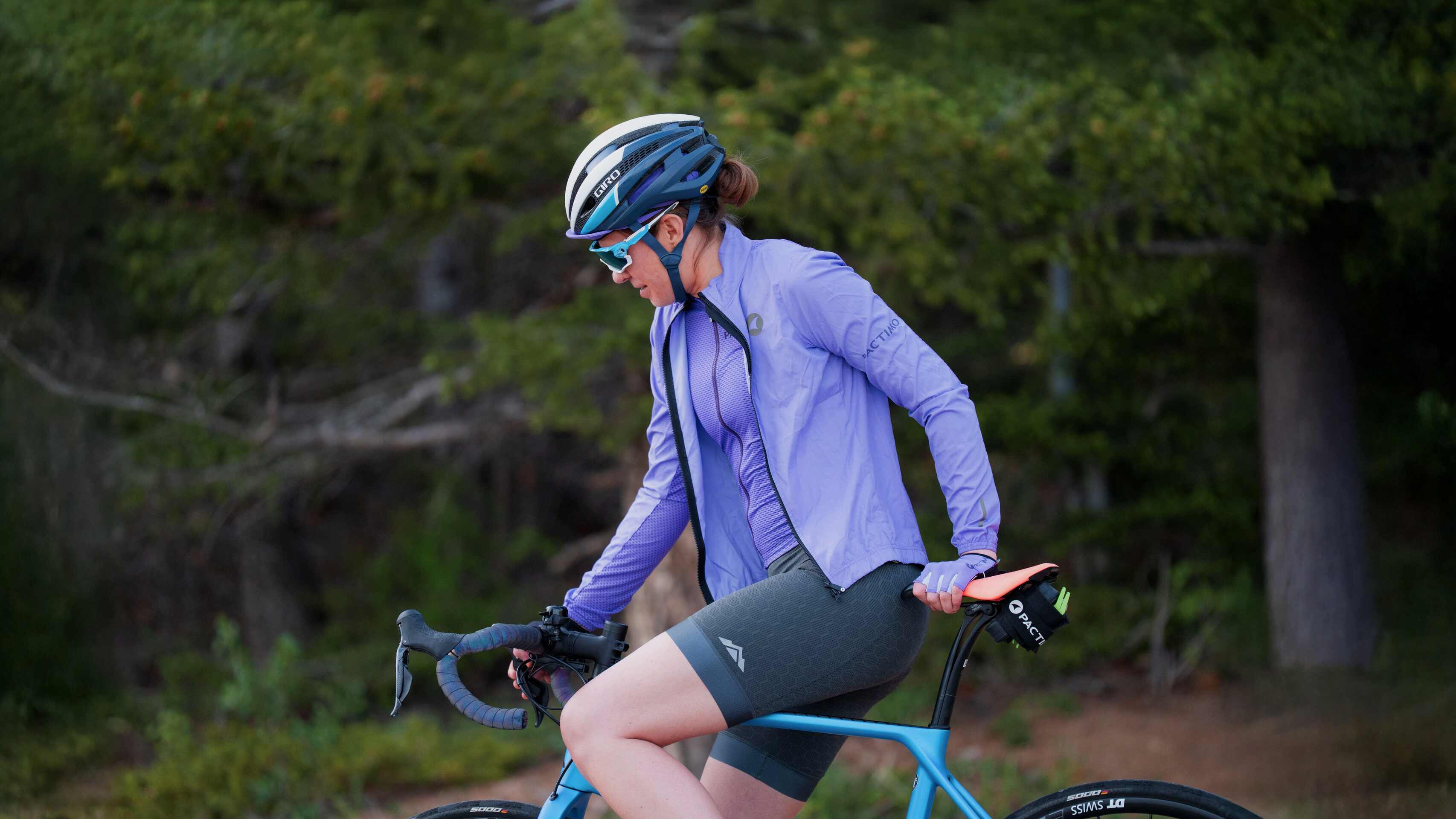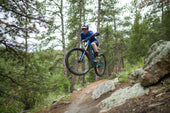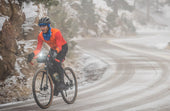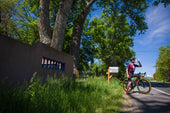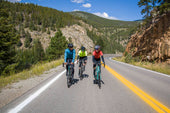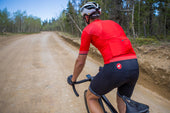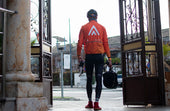Cyclists have their own lingo and language. Hopefully this list will help make sense of it all.
. . . . . . . . . . . . . . . . . . . .
A
abandon:
When a rider quits a race for any reason.
aero:
Slang for aerodynamic or streamlined. Anything that helps a cyclist combat wind. Aero devices include handlebars, bullet-shaped helmets, jerseys, and skinsuits.
aero bars:
Handlebars or bolt-on (often called “clip-on”) bars made for road riding that put you in a streamlined position for more speed with the same effort. These usually include elbow pads, which support your weight. The bars place your hands in front of the body, where they poke a hole in the air, which decreases wind resistance. Using aero bars and finding an aerodynamically optimum riding position are the best ways to reduce your time in time trials, triathlons, even centuries.
aero helmet:
A special helmet with a streamlined shape to reduce wind drag and offer an advantage in races against the clock.
aerobic:
Exercise at an intensity that allows the body’s need for oxygen to be continually met. This intensity can be sustained for long periods.
aerodynamic, aero:
Cycling equipment designed for or a riding position that reduces wind resistance; aero for short.
alloy:
A blend of metals. Also slang for “aluminum.”
Alpe d’Huez:
A legendary Tour de France climb to the French ski station of the same name, Alpe d’Huez is renowned for its brutal steepness and 21 switchbacks, each bearing the name of a past Tour stage winner. The Alpe became the Tour’s first mountaintop finish when the then-unpaved climb was used in 1952. Fausto Coppi won the first stage to use the 8.6-mile, 7.9%-grade climb with a time of 45 minutes and 22 seconds. Now paved, debate remains as to who holds the record for the fastest ascent of the climber’s crown jewel. Marco Pantani is generally acknowledged to be the fastest at 37’35”.
aluminum:
A super-light, durable and affordable material that’s widely used for bicycle frames and components.
anaerobic:
Exercise above the intensity at which the body’s need for oxygen can be met. This intensity can be sustained only briefly.
anti-zipper ripple:
Jerseys featuring the anti-zipper ripple technology will have a shorter cut front, allowing for a skintight fit in the riding position. Not only does the design prevents excess fabric bulging, and thereby reduce discomfort and chaffing, it dramatically increases aerodynamics. (See: New to Cycling - Bike Jerseys)
Anquetil, Jacques:
A French road racer who is the first person to win the Tour de France five times. Before the 1961 Tour he said he would warm the yellow jersey on day one and wear it all through the tour, a feat he indeed accomplished.
apex:
The shortest distance through a turn.
arm warmers:
Sleeves for keeping your arms warm. They’re easy to put on and remove and they easily fit in a jersey pocket. (See: New to Cycling - Arm, Leg & Knee Warmers)
attack:
An aggressive, high-speed jump away from other riders.
audax:
A cycling sport in which a group of participants attempt to cycle long distances within a pre-defined time limit, at a steady pace set by a road captain. Typically the group aims to cycle at 22.5 km/h.
autobus:
A stage racing term used to denote a group of racers riding near the back, who work together to finish the stage just before the time limit expires.
B
bacon:
Slang for scabs, cuts, scars and other scrapes and abrasions from crashing. See also: road rash.
bail:
To ditch (or toss away) your bike before a crash, oftentimes done mid-flight during a jump.
balaclava:
A thin hood that covers the head and neck with an opening for the face. It’s worn under the helmet to prevent heat loss in cold or wet conditions.
bead:
The edge inside a tire along each side’s inner circumference that fits into the rim.
bell lap:
In races with laps (such as criteriums, which typically race around city blocks, or cyclocross, which follows a fixed route) a bell is used to signal a one-lap mid-race contest where the winner of that lap gets a prize (called a prime), or that the riders are on the final lap.
bibs:
Also called bib shorts, they are cycling shorts with suspenders designed of Lycra or mesh to be lightweight, breathable and easy on your shoulders. They are the choice of professional cyclists because of their exceptional comfort. (See Why Cyclists Choose Bib Shorts)
biff:
Slang for crash.
big ringing:
Riding a "big" gear. When the rider has his chain on the larger of the two front chainrings, allowing them to go for maximum speeds. Most often used on rolling or flat terrains.
blocking:
Legally impeding the progress of opposing riders to allow teammates a better chance of success.
blood glucose:
With some exceptions, glucose, or blood sugar, is the primary source of energy for the body’s cells.
blow up:
To suddenly be unable to continue at the required pace due to overexertion.
bonk:
A state of severe exhaustion caused mainly by the depletion of glycogen in the muscles because the rider has failed to eat or drink enough. Once it occurs, rest and high-carbohydrate foods are necessary for recovery.
bonus sprints:
During stage races, race organizers will designate several locations along the route where bonus points are given to the first three riders that cross an arbitrary sprint line. These sprints create a "race within a race" during each stage.
boot:
A small piece of material used inside a tire to cover a cut in the tread or sidewall. Without it, the tube will push through and blow out.
bottom bracket:
The part of the frame where the crankset is installed. Also, the axle, cups and bearings of a traditional crankset, or the axle, retainer rings and bearing cartridges of a sealed crankset.
bpm:
Abbreviation for beats per minute in reference to heart rate.
break, breakaway:
A rider or group of riders that has escaped the pack.
brevet:
Pronounced “brevay,” it is a long-distance event used to qualify riders for major randomness (see below) such as Paris-Brest-Paris. The typical brevet series has rides of 200, 300, 400 and 600 km.
bridge, bridge a gap:
To catch a rider or group that has broken away or opened a lead.
broom wagon:
The last vehicle in a race caravan, that “sweeps” the course and picks up crashed, broken-down and off-the-back riders who can’t continue.
bunch:
The main cluster of riders in a race. Also called the group, pack, field or peloton.
bunch sprint:
The mass dash for the line at the end of a stage when the whole race is still together. Despite the name, a bunch sprint isn't contested by the whole field - the riders at the front are the specialist sprinters and their lead-out men.
bunny hop:
A way to ride over obstacles such as rocks or potholes in which both wheels leave the ground.
C
cadence:
The number of times during one minute that a pedal stroke is completed. Also called pedal rpm.
cage:
The part of the front derailleur the chain passes through. Also, that thing that holds your water bottle (or bidon in the UK), which is called a bottle cage.
calipers:
That part of sidepull, centerpull and disc brakes that attaches to the frame and holds the brake shoes.
Campagnolo:
A revered Italian manufacturer of road components and wheelsets. Founded by Tullio Campagnolo in 1933.
campy:
Slang for Campagnolo.
cantilever brakes:
A type of brake comprised of two arms that bolt to posts attached to the frame and fork with a crossover cable that connect the two. Common on mountain and touring bikes.
captain:
The front person on a tandem.
caravan:
The motorized “circus” that accompanies most major professional stage races and even some amateur events, the caravan is composed of officials’ vehicles, motorcycle police, team cars, medical vans and photographers hanging precariously off the back of even more motorcycles.
carbohydrate:
In the diet, carbohydrates are broken down to glucose, the body’s principal energy source, through digestion and metabolism. Glycogen is stored in the liver and muscles. Carbs can be either “simple” (sugars) or “complex” (bread, pasta, grains, fruits, vegetables). One gram of carbohydrate supplies four calories.
carbo-loading:
A popular energy-boosting practice for the days before a race or event, where the cyclist consumes as many carbohydrates as possible to store fuel for the race.
carbon fiber:
One of the lightest frame and component materials, carbon fiber (also called just carbon) is unique in that it’s a fabric, not a metal. This allows gossamer weights, incredible strength and impressive frame/fork compliance (vibration damping) because the fibers can be oriented in myriad ways.
cardiovascular:
Pertaining to the heart and blood vessels.
cassette:
The set of gear cogs on the rear hub. Also called a freewheel, cluster or block.
catch air:
When both wheels leave the ground, usually because of a rise or dip in the riding surface.
categories:
The division of racers based on ability and/or experience.
categorized climb:
Most of the Tour’s major ascents are ranked according to certain guidelines, though it’s not all set in stone. In decreasing order of difficulty, official climbs are rated 1, 2, 3, and 4, though the toughest climbs are considered “beyond category” (see: hors catégorie).
century:
A 100-mile ride.
chain suck:
When the chain sticks to the chainring teeth during a downshift and gets drawn up and jammed between the small ring and the frame.
chainring:
A sprocket on the crankset. There may be one, two or three. Short version is ring.
chainstay:
The thin frame tube that extends from the rear dropout to the bottom bracket, where the bike’s crankset is located. There is a chainstay on each side of the rear wheel.
chamois:
Pronounced like shammy, it's the pad found inside most cycling shorts that cushions, wicks and breathes to ensure comfort and protection. It also reduces friction and is seam-free to eliminate pressure points and chafing. Originally made of a thin leather just like the chamois you might use to dry your car, today most are made of synthetic material, which often even includes antibacterial properties for additional protection and comfort.
Champs-Élysées:
The famous cobbled boulevard in downtown Paris that hosts the finish of the final stage of the Tour de France. Riders make several laps of a circuit that takes them around the Arc de Triomphe, through the Place de la Concorde, and up and down both sides of the Champs.
chasers:
Those who are trying to catch a group or a lead rider.
chondromalacia:
A serious knee injury in which there is disintegration of cartilage surfaces due to improper tracking of the kneecap. Symptoms start with deep knee pain and a crunching sensation during bending.
circuit:
A course that is ridden two or more times to compose the race.
circuit training:
A weight training technique in which you move rapidly from exercise to exercise without rest.
classic:
Traditionally, a single-day European road race on the professional calendar. Examples include Paris-Roubaix, Milan-San-Remo and Liege-Bastogne-Liege.
cleat:
A metal or plastic fitting on the sole of a cycling shoe that engages the pedal.
climb categories:
Climb categories are used in the Tour de France to rate difficulty. Climbs are ranked on a scale of 1 to 3, with Category 1 being the most severe. Riders are awarded points toward the King of the Mountains competition based on two things: their order over the top and the climb’s difficulty. The harder the climb, the more points are available. There is also a “beyond category” climb called the Hors Categorie (HC). Its extreme difficulty makes it a big factor in stage races because better climbers can pick up more points here and make up time on their rivals.
clincher:
A conventional tire with a separate inner tube.
clipless pedals:
Composed of two parts, the pedal and the cleat, clipless pedals are similar to using ski bindings, which allow you to clip into your pedals for a more efficient pedal stroke. The “clipless” in the name refers to the old technique which required the use of toe clips and straps.
clydesdale:
A large rider.
cog:
A sprocket on the rear wheel’s cassette or freewheel.
coldblack®:
A special finishing technology for textiles which reduces heat build-up and provides reliable protection from UV rays.
compact crankset:
A double-chainring crankset designed to provide easier gearing by using smaller chainrings than found on standard cranksets. These typically feature 39 and 53-tooth rings, while compacts usually have 34 and 50-tooth rings.
contact patch:
The portion of a tire in touch with the ground.
corncob:
A cassette in which each cog is only one tooth larger than the previous one. Also called a straight block.
criterium:
A mass-start race covering numerous laps of a course that is normally about one mile or less in length. Also call a “crit.”
crosstraining:
Combining sports for mental refreshment and physical conditioning, especially during cycling’s off-season.
cyclocross:
A type of off-season bicycle racing (usually held October through January) around a loop course, which includes natural and man-made obstacles that force dismounting and running while carrying the bike. It was invented in Europe to keep racers fit through the winter.
cyclocross bike:
A bicycle designed for the rigors of cyclocross racing with a light, responsive and rugged frame, fork and wheels, plus wide gearing, grippy tires and ample mud clearance. Most typically employ disc brakes for their exceptional performance in adverse conditions. Cyclocross bicycles can be used for commuting, training, off-roading and training, too.
D
derailleur:
Also called a “shifter” or in England, a “mech,” a derailleur is a mechanism that literally derails the chain moving it to another cog or chainring. There are rear and front derailleurs. The rear shifts the chain across the cogs. The front moves the chain between the chainrings. You must be pedaling to shift and it’s best to use light pedal pressure when shifting.
directeur sportif:
French for “sport director,” the directeur sportif is responsible for managing almost all logistical concerns of the racing team he/she is in charge of. At the highest levels of cycling, the directeur sportif drives behind the peloton watching live race coverage on a dashboard-mounted TV and informs his team on proper race strategy via radio. He may also pass out drinks and help with medical or mechanical issues.
disc brake:
A type of brake system that uses discs (called rotors) that are attached to the wheel hubs and calipers attached to the frame that grip the rotors when the levers are squeezed. Discs provide maximum speed control and stopping power even in wet and muddy conditions. Plus, wheel damage won’t compromise braking the way it can with rim brakes since the rims are not relied upon for braking.
disc wheel:
A bicycle wheel with covers or a solid disc as opposed to having visible spokes. While disc wheels are heavy, they are extremely aerodynamic. They can also be very difficult to ride in a strong crosswind.
DNF:
What you don’t want to see next to your name after an event. It stands for Did Not Finish.
DNR:
Short for Did Not Race. If you register for a bicycle race or a century ride and then for some reason can’t be there to ride it, the officials will usually put DNR next to your name. DNS is also used, for Did Not Start.
DNS:
Short for Did Not Start. If you register for a bicycle race or a century ride and then for some reason can’t be there to ride it, the officials will usually put DNS next to your name. DNR is also used, for Did Not Race.
domestique:
A racer who sacrifices his own chance of victory to help a teammate win. Tasks of a domestique may include: carrying extra bottles and food for fellow riders, chasing breakaway groups, and even giving their bikes to the designated team leader should he/she have a mechanical problem.
doping:
Originally meant in reference to blood doping, or withdrawing blood to re-inject it later on to boost red blood cell count and oxygen uptake. Now meant to include any performance-enhancing substances, whether chemical, physical or mechanical, which are banned from competitive use.
downshift:
To shift to a lower gear, i.e. a larger cog or smaller chainring.
drafting:
Riding closely behind another rider to take advantage of the windbreak (slipstream) and use about 20-30 percent less energy. Also called sitting in or wheelsucking.
drivetrain:
The components directly involved with making the rear wheel turn, i.e. the chain, crankset and cassette. Also called the power train.
dropout:
On a bike frame, the slots into which the front and rear wheel axles fit.
dropped:
When you’re not fit enough to ride with the group, you risk getting left behind, or “dropped.”
drops:
The lower part of a down-turned handlebar typically found on a road bike. The curved portions are called the hooks.
E
eat it:
Slang for crash.
echappee:
French for "escapee," a cyclist who escapes from the pack.
echelon:
A form of paceline in which the riders angle off behind each other to get maximum draft in a crosswind.
elastomer:
A compressible, rubber-like material used to absorb shock in some suspension systems.
electrolytes:
Substances such as sodium, potassium, and chloride that are necessary for muscle contraction and maintenance of body fluid levels. These can be replenished through electrolyte drinks and supplements such as Nuun.
endo:
To crash by going over the bike’s handlebar. Short for end over end.
enduro:
A type of mountain bike racing where the downhills are timed, and the uphills are mandatory but not timed but usually must be completed within a time-limit. Enduros typically take place over one or two days, however, week-long competitions also exist.
equipe:
French for "team."
ergometer:
A stationary, bicycle-like device with adjustable pedal resistance used in physiological testing or for indoor training.
F
faceplant:
Slang for a bicycle accident that results in your face contacting the pavement.
false flat:
1. A surprisingly difficult section of road that looks flat but is actually slightly uphill. Usually, no matter how hard you pedal you go way slower than you think you should be going.
2. A stretch on a long hill that looks flat and tricks you into thinking you’ve reached the top when there’s still more climbing to come.
fartlek:
A Swedish word meaning “speed play,” it is a training technique based on unstructured changes in pace and intensity. It can be used instead of timed or measured interval training.
fat:
In the diet it is the most concentrated source of food energy, supplying nine calories per gram. Stored fat provides about half the energy required for low-intensity exercise.
fat bike:
Not to be confused with “fat-tire bikes,” which is a moniker for mountain bikes, fat bikes are a new type of all-terrain bicycle that feature super-wide frames, wheels and tires (often over 4 inches wide), that make it possible to ride over snow and sand with ease.
feed zone:
A designated area on a race course where riders can be handed food and drinks.
ferrules:
Metal or plastic caps that fit on the ends of cable housing. There are several types. Some are used to provide a perfect fit between the housing and stops the housing fit into on the frame. Others customize the end of the housing to fit in the brake and shift levers. Pronounced as fair – rules.
field sprint:
The dash for the finish line by the main group of riders.
fixed gear:
A direct-drive setup using one chainring and one rear cog, as on a track bike. When the rear wheel turns so does the chain and crank; coasting isn’t possible.
flamme rouge:
A red flag that hangs from an inflatable banner 1K from the end of each stage to let the riders know the finish is approaching.
flash:
Black on the outside, grey on the inside, this polyester hydrophobic “water-fearing” fabric from Swiss-manufacturer Eschler pushes water and heat away from the skin. With the durability of nylon on exterior and the comfort of polyester on interior, this lightweight, breathable fabric is extremely flexible and Eco-friendly.
freewheel:
A cluster of cogs that’s screwed onto the rear wheel. It includes the bearings and drive mechanism. “Freewheel” also means to “coast.”
full tuck:
An extremely crouched position used for maximum speed on descents.
G
gap:
The amount of time or distance between a rider or group of riders and another rider or group of riders.
gear ratio:
This is used to compare gearing. For example, on a road bike with 18 gears, there are 2 chainrings and 9 cogs. To check the gearing, count the teeth on the cogs and chainrings and create a chart with the rings on top and the cogs on the side. Then, to calculate each gear ratio, divide the chainring by the cog and multiply by 27 (rear wheel diameter). Put the numbers in the chart so you can compare and understand. The larger the number, the harder it is to pedal the gear. By comparing the numbers, it’s possible to find overlapping gears and gaps that you might want to change to improve the gear ratios.
general classification:
The overall standings or leader board in a stage race, representing each rider's total cumulative time in the race. Often referred to as GC. The rider with the lowest time is number one on the G.C.
giro d’Italia:
In English, the Tour of Italy. It is the second most important stage race on the professional calendar after the Tour de France and one of the three Grand Tours.
glutes:
The gluteal muscles of the buttocks. They are key to pedaling power.
glycogen:
A fuel derived as glucose (sugar) from carbohydrate and stored in the muscles and liver. It’s the primary energy source for high-intensity cycling. Reserves are normally depleted after about two-and-a-half hours of riding.
glycogen window:
The period within an hour after exercise when depleted muscles are most receptive to restoring their glycogen content. By eating foods or drinking fluids rich in carbohydrate, energy stores and recovery are enhanced.
gorp:
“Good ol’ raisins and peanuts,” a high-energy mix for nibbling during rides. Can also include nuts, seeds, M&Ms, granola, etc.
grand départ:
French for “great departure,” it’s the start of the Tour de France. This often takes place in France itself, but has increasingly gone to foreign cities to generate international interest in the race.
grand tour(s):
The three most prestigious road races in professional cycling, each held annually over the course of three weeks: the Giro d’Italia in May, the Tour de France in July and the Vuelta a España in August.
granny gear:
The lowest gear ratio, combining the small chainring with the largest cassette cog. It’s mainly used for very steep climbs. Named after the gear that grandmothers use most frequently.
granny ring:
The smallest of the three chainrings on a triple crankset.
green jersey (maillot vert):
First awarded in 1953, it goes to the leader of the Points Classification. Riders can earn these points at stage finishes and certain mid-stage sections (see: intermediate sprint). Flat stages award the most green jersey points, which is why field sprinters often win the competition.
grupetto:
Italian for "small group." Large groups of dropped riders that often form at the back of the race on mountain stages are called grupettos. Grupettos are generally filled with sprinters and riders who have finished working for their team leaders that day.
H
hammer:
To ride strongly in big gears..
hamstrings:
The muscle on the back of the thigh, not well developed by cycling.
hanging in:
This is what you do when you’re tired on a group ride, but keep trying and manage to stick to the back of the group.
headset:
The parts at the top and bottom of the frame’s head tube, into which the handlebar stem and fork are fitted.
head tube:
The frame tube that the fork fits into.
Hinault, Bernard:
French road racer known as Le Patron (The Boss) or Le Blaireau (The Badger) for his aggressive riding style and ownership of the peloton. He won the Tour de France five times in the late 1970's and early 1980's.
hors catégorie:
French for “beyond category,” a rating reserved for the most challenging climbs, such as the Alpe d’Huez. (See: Categorized Climbs)
hybrid:
A bike that combines features of road and mountain bikes. Also called a cross bike.
hydrate:
To drink. Do it often while riding! (See: Cycling and Hydration)
I
Induráin, Miguel:
Spanish road racer known as "Big Mig" who won the Tour de France five times between 1991 and 1995. He is the only five-time winner to achieve those victories consecutively.
intermediate sprint:
Found in the middle of each stage, this section awards points in the Tour’s green jersey competition. The first 15 riders to cross the line at these locations earn points.
intervals:
A structured method of training that alternates brief, hard efforts with short periods of easier riding for partial recovery.
J
jam:
A period of hard, fast riding.
jersey:
A shirt made for cycling. Jerseys are often brightly colored for visibility when riding. And they’re made of fabrics that wick moisture away from the skin to keep you dry and comfortable while pedaling. Usually they have rear pockets for carrying energy food, tools and clothing you might need or have removed. And, they often have long zippers, which are great for cooling off on hot days.
jump:
A quick, hard acceleration.
K
King of the Mountains (KoM):
A competition for the best climber, which runs on a points system similar to the sprinters jersey. In the Tour de France, the leader wears a polka dot jersey.
kit:
A cycling jersey and shorts, typically with matching artwork, is called a kit.
knee warmers:
Sleeves worn over your knees and lower legs to keep the all-important leg muscles, tendons and ligaments warm. Knee warmers are easier to take off and tuck in a jersey pocket than tights are, which is why they’re favored by many riders.
L
lactate threshold (LT):
The exertion level beyond which the body can no longer produce energy aerobically, resulting in the buildup of lactic acid. This is marked by muscle fatigue, pain and shallow, rapid breathing. Also called anaerobic threshold (AT).
lactic acid:
A substance formed during anaerobic metabolism when there is incomplete breakdown of glucose. It rapidly produces muscle fatigue and pain. Also called lactate.
lanterne rouge:
This is the competitor in last place in a cycling race such as the Tour de France. The phrase comes from the French “Red Lantern” and refers to the red lantern hung on the caboose of a railway train, which conductors would look for in order to make sure none of the couplings had become disconnected.
LBS:
Local bike shop.
leadout:
A race tactic in which a rider accelerates to his maximum speed for the benefit of a teammate in tow. The second rider then leaves the draft and sprints past at even greater speed near the finish line.
leadout man:
A rider who specializes in providing a wheel for a sprinter to follow in the final stages of a race. Nestled in the lead-out man's slipstream, the sprinter waits for the final possible moment, then accelerates for the line as the lead-out man pulls to one side. Pairings of sprinter and lead-out man often travel together from team to team, but not always.
LeMond, Greg:
The first (and only officially recognized) American to win the Tour de France. He won 3 times in 1986, 1989 and 1990.
lieutenant:
The team leader’s right-hand man who helps keep things organized during the stage. The lieutenant also plans and executes strategy, like chasing down breakaways or setting up the final sprint.
line:
Or, “the line.” “The good line,” this is the best path through a technical section. “The line” can also mean the finish line.
LSD:
Long, steady distance. A training technique that requires a firm aerobic pace for at least two hours.
lycra:
A fabric made by DuPont that’s highly breathable, stretchy and comfortable. It’s widely used in cycling clothing because it fits so nicely and moves so well with the body when you’re riding. It’s also extremely durable.
M
maglia rosa:
Italian for “pink jersey,” the maglia rosa is the jersey worn by the current race leader in the Giro d’Italia (Tour of Italy), which is the second most important professional stage race after the Tour de France. “Maglia rosa” is also used to refer to the race leader himself. TV commentators might say, “The Maglia Rosa is riding well today.” The jersey’s color comes from the Italian sports tabloid and race sponsor, La Gazzetta dello Sport, which is printed on pink paper.
maillot à pois rouges (polka dot jersey):
First given in 1975, it goes to the leader of the King of the Mountains competition in the Tour de France. Riders earn points at the top of each categorized climb.
maillot blanc (white jersey):
Created in 1975, it recognizes the Best Young Rider in the Tour de France, or the rider under age 26 with the highest position on the General Classification.
maillot jaune (yellow jersey):
Pronounced mayo – june, it is French for yellow jersey and what the leader and winner of the Tour de France wears.
maillot vert (green jersey):
First awarded in 1953, it goes to the leader of the Points Classification in the Tour de France. Riders can earn these points at stage finishes and certain mid-stage sections (see: intermediate sprint). Flat stages award the most green jersey points, which is why field sprinters often win the competition.
mash:
Pushing hard on the pedals.
mass start:
Events such as road races, cross-country races and criteriums in which all contestants leave the starting line at the same time.
mechanical:
Slang for a problem with the bicycle. "He had a mechanical."
Merckx, Eddie:
One of the greatest road racers in cycling history, dubbed the “Cannibal” for how he devoured opponents often riding off the front seemingly effortlessly. “Eddie” as he is commonly called, won the Tour de France 5 times.
messenger bag:
A type of pack favored by bike messengers (because they can get into it without removing it), that’s slung over the head and shoulder bandolier style.
metric century:
A 100-kilometer ride (62 miles).
minuteman:
In a time trial, the rider who is one place in front of you in the starting order. So called because in most TTs riders start on one-minute intervals.
moto:
A moto is song for a motorcycle used in in racing. Some motos are for officials while others are used by journalists ride TV to report the standings, time gaps and rider issues. (See: What It’s Like to Ride a Race Motorcycle in the Tour de France)
motorpace:
A training technique involving riding behind a car or motorcycle to develop the ability to ride at higher speeds. It’s not a good idea to try this behind the family car, for safety, special roller devices are used on the backs of real motorpacing vehicles.
mountain climb classifications:
Large mountain climbs are normally classified according to their difficulty. Category 4 is the easiest, followed by Categories 3, 2, 1, and the Hors-Categorie (which is the hardest). Mountain climbs are classified according to their length and the average gradient of the road's incline.
mudguards:
Fenders.
musette:
Also called a musette bag, this pouch with shoulder strap is stuffed with food and handed to racers as they pass through the feed zone.
N
neutral support:
At a ride or race, neutral support means if you have a mechanical issue there is assistance on the course available to all riders (versus in racing where team riders receive support from their own mechanics who will not help other riders).
neutral zone, neutral section:
Usually reserved for racing, a neutral zone is a section of the course where you’re not allowed to race and have to remain behind the lead vehicle(s). For example there might be a neutral zone for a few miles to allow the race vehicles and competitors to get across a strip of highway before getting onto the official racecourse. Once on the course, the lead vehicles will typically signal the field to start racing and then speed up the road.
nipple:
Also called a “spoke nipple,” this is an oddly shaped nut that attaches to the end of the spoke, usually found at the rim. You turn nipples with a spoke wrench to true the wheel.
O
off the back:
Describes one or more riders who have failed to keep pace with the main group. Also referred to as OTB.
off-the-front:
Rolling away from the group on a training ride or race. Considered rude if it’s an easy day or friendly spin and apt to turn any group ride into a race. It also means being well ahead of the pack in a race. So, if you attacked and no one stayed with you, you’d be off the front.
organ donor:
Cycling slang for one who rides without a helmet.
orthotics:
Custom-made supports worn in shoes to help neutralize biomechanical imbalances in the feet or legs.
overgear:
Using a gear ratio too big for the terrain or level of fitness.
overlap wheels:
The dangerous practice of positioning yourself on a group ride so that your front wheel overlaps someone’s rear wheel. If that person swerves, their wheel will hit yours, and you will almost always crash or eat it.
overtraining:
Deep-seated fatigue, both physical and mental, caused by training at an intensity or volume too great for adaptation.
oxygen debt:
The amount of oxygen that must be consumed to pay back the deficit incurred by anaerobic work.
P
paceline:
A line of riders (all it takes is two, yet the more there are, the better it works) traveling closely together and taking turns in the lead in order to save energy, share the work and travel more quickly than possible if riding alone. There are many types of pacelines, such as single and double ones, but the goal is always the same, to cover the distance more efficiently by riding closely together, sharing the work of riding in front and breaking the wind, while your riding partners rest and get ready for their “pull” at the front when the time comes.
pack:
Or “the pack,” this is used to refer to the main group of riders sticking together in an event or race.
pack fodder:
Negative term used by more aggressive riders about those riding with the group who never take a pull at the front.
palmarès:
A bicycle racer’s list of achievements, accomplishments or wins.
panniers:
Bags that mount to front and/or rear racks for carrying gear, primarily used for touring or commuting. Also called “saddlebags.”
Paris-Brest-Paris:
A historic race which is one of the most important randonneuring event of the cycling season. It travels from Paris to Brest and back to Paris, a distance of 745 miles (1,200 kilometers) that must be completed in 90 hours. While food and rest stops are allowed, riders must be self-supported carrying the spares and all equipment needed such as lighting, fenders, rain gear, etc. PBP goes back to 1891 and takes place every four years in August. To qualify you must complete a series of rides called “brevets,” 200, 300, 400 and 600K in length. Riders who manage to qualify and finish PBP within the time limit get their names entered in the official records of the Audax Club Parisien, and have the satisfaction of knowing they conquered one of the toughest events in all of cycling.
Paris–Roubaix:
A one-day road race in northern France, starting north of Paris and finishing on the Belgian frontier. From its beginning in 1896 until 1967 it started in Paris and ended in Roubaix; since 1968 the start has been in Compiègne (about 85 kilometres (53 mi) north-east from Paris centre). The finish is still in Roubaix. Famous for rough terrain and cobblestones, it is one of the classics of the European calendar, and contributes points towards the UCI World Ranking. It has been called “Hell of the North.”
patch kit:
A kit for repairing flat tubes. It usually comes in a small plastic box and includes patches, glue and sandpaper.
pavé:
French for a cobblestone road.
peak:
A relatively short period during which maximum performance is achieved.
peloton:
The main group of riders in a race or large event.
pinch flat:
An internal puncture marked by two small holes caused by the tube being squeezed against the rim. It results from riding into an object too hard for the air pressure in the tube. Also called a snakebite.
polka dot jersey (maillot à pois rouges):
First given in 1975, it goes to the leader of the King of the Mountains competition in the Tour de France. Riders earn points at the top of each categorized climb.
portage:
To carry your bike.
power:
The combination of speed and strength.
presta:
The narrow European-style valve found on some inner tubes. A small metal cap on its end must be unscrewed before air can enter or exit.
prime:
A special award given to the leader on selected laps during a criterium, or the first rider to reach a certain landmark in a road or cross-country race. It’s used to heighten the action. Pronounced “preem.”
prologue:
A short stage held as the opener of the Grand Tours. It’s usually less than 5 miles long and designed mainly as a showcase kick-off (and a way to get the yellow jersey on someone’s back right away).
protein:
In the diet it is required for tissue growth and repair. Composed of structural units called amino acids. Protein is not a significant energy source unless not enough calories and carbohydrate are consumed. One gram of protein equals four calories.
psi:
Abbreviation for pounds per square inch. The unit of measure for tire inflation and air pressure in some suspensions.
publicity caravan:
A huge procession of vehicles that traces the day’s route before the pack. Each Tour sponsor has at least one car, making the caravan bigger than the race itself in terms of personnel.
pull, pull through:
Take a turn at the front.
pull off:
To move to the side after riding in the lead so that another rider can come to the front.
puncheur:
French for "puncher", a rider who specializes in rolling terrain with short, steep climbs. Classics specialist Philippe Gilbert is prehaps one of cycling's most famous puncheurs.
pursuit:
A track cycling event where riders start on opposite sides of the track and race over a set distance (4K for men, 3K for women). The racer who finishes the distance the quickest wins. It’s an exciting event to watch as you can see who is ahead and a rider might even catch his opponent.
pusher:
A rider who pedals in a large gear at a relatively slow cadence, relying on the gear size for speed.
Q
quadriceps:
The large muscle in front of the thigh, the strength of which helps determine a cyclist’s ability to pedal with power.
queen stage:
The hardest, most demanding stage of a stage race and is always in the high mountains.
quick release:
A clamping mechanism used to hold on wheels and sometimes used to secure seatposts in the frame. Quick releases make it easy to remove wheels for storage or flat-tire repair. You’ll also find quick releases on seatposts and sometimes other parts such as handlebars on some folding bicycles.
quick‑release skewer:
The part of the quick-release mechanism that passes through the part it secures. Also called the quick-release “rod.”
R
RAAM:
The Race Across America, contested from the west coast to the east every year since 1982.
radial spoking:
This is a spoke pattern on which the spokes run directly from the hub to the rim without crossing other spokes.
rainbow jersey:
The jersey earned and worn by the world road-race champion. It sports the rainbow stripes (green, yellow, black, red and blue).
rainbow stripes:
Symbol of the world road-race champion and often used to decorate components and clothing associated with the title. The stripes are green, yellow, black, red and blue.
randonnee:
A long-distance event in which riders must navigate a prescribed course while passing through intermediate checkpoints within certain time limits.
randonneur:
A cyclist who does long-distance endurance riding with no outside support, typically not for competition but to complete the course within a certain time limit. According to Randonneurs USA “friendly camaraderie, not competition, is the hallmark of randonneuring.” Randonneuring goes back to the beginnings of cycling. The most famous event is Paris-Brest-Paris, a 746-mile test that has to be completed within 90 hours.
reach:
The combined length of a bike’s top tube and stem, which determines the rider’s distance to the handlebar.
rear triangle:
That part of a bicycle frame comprised of the seat tube, chainstays and seatstays. It’s called a “rear triangle” because it’s behind the frame’s “main triangle,” which is made up of the seat tube, top tube, down tube and head tube.
recovery bar:
An energy food that’s eaten after rides to recover more quickly.
recovery drink:
An energy drink for after rides to recover more quickly.
recumbent:
Bicycles designed around a reclined instead of an upright body position. On recumbents you sit in a seat that resembles a lawn chair (complete with backrest) and pedal with your legs out in front of your body. These unique bicycles come in a variety of configurations but all offer great comfort because they support more body weight and eliminate pressure on the hands, arms, neck, etc.
repair stand:
Also called a “workstand,” this is a support that holds your bicycle in the air to make maintenance and repair easy (and save your lower back).
repetition:
Each hard effort in an interval workout. Also, one complete movement in a weight-training exercise; rep for short.
resistance trainer:
A stationary training device into which the bike is clamped. Pedaling resistance increases with pedaling speed to simulate actual riding. Also known as an indoor, wind, fluid, or mag trainer (the last three names derived from the fan, liquid, or magnet that creates resistance on the rear wheel).
revitaillement:
French for taking on food and drink, usually in the feed zone. Contrôl de revitaillement is French for the Feed Zone.
rim:
The outermost part of the wheel. The tire mounts to the rim. On bicycles with caliper hand brakes (not disc brakes), the rim is part of the braking system.rim cementAlso called “glue”, this is the adhesive that’s applied to rims to mount sew-up (also called “tubular”) tires.
rim strip:
The cloth or rubber strip inside a wheel that keeps the spoke holes/nipples from poking holes in the tube.
road furniture:
Concrete medians and barriers put in roads to slow traffic. The roads of northern Europe, in particular, are filled with road furniture and it can make bicycle racing there dangerous.
road rash:
Also called a “raspberry,” “strawberry” or “bacon,” this is the painful scrape(s) suffered from crashing and sliding down the road.
roadie:
Someone who favors road riding.
road race:
A mass-start race on pavement that goes from point to point, covers one large loop or is held on a circuit longer than those used for criteriums.
rock garden:
A section of trail with so many large, immovable rocks, it takes skill to ride through it without putting your foot down or walking.
rollers:
1. A series of small hills on a track or trail that are typically rolled (coasted) or manualed over (extended wheelie), not jumped.
2. An indoor training device comprised of a frame holding 3 or 4 rollers on which you place your bike to pedal in place. The rollers let you pedal in place and steer as you would riding outdoors. Unlike on stationary trainers, you must balance to ride rollers (unless yours are equipped with a bicycle support).
roof rack:
A rack for carrying bicycles that mounts to the roof of your car.
road rash: any skin abrasion resulting from a fall. Also called crash rash.
rollers: an indoor training device consisting of three long cylinders connected by belts. Both bike wheels roll on these cylinders so that balancing is much like actual riding.
rotor:
The “disc” part of disc brakes, rotors are the thin, flat circular metal plates that attach to the hubs and are what the brake calipers grip to slow and stop your bike when you squeeze the brake levers.
rouleur:
A rider who specializes in steady, consistent riding. Rouleurs are often 'super-domestiques' able to provide a wheel for the team leader for hours at a time.
route sheet:
A type of map handed out at the beginning of organized rides that simply lists every turn on the course and the distance to it. Much easier to follow while riding than using a map. Sometimes called a “turn sheet.”
RPM:
For Revolutions Per Minute, this is how you calculate your “cadence,” or pedaling speed. Simply count the number of complete pedal revolutions (one side) you do in 15 seconds and multiply by 4 to determine how fast you’re spinning. A good target for fitness riders is to maintain 70 to 90 RPM.
S
saddle:
Also called a “seat,” this all-important device supports you and has a lot to do with how comfortable you are when riding.
saddle sores:
Skin problems in the crotch that develop from chafing caused by pedaling action. Sores can range from tender raw spots to boil-like lesions if infection occurs.
saddle time:
Time spent cycling.
sag wagon:
A motor vehicle that follows a group of riders, carrying equipment and lending assistance in the event of difficulty. Also called the broom wagon. SAG is an acronym for “support and gear” or “support and grub.”
schrader:
An inner tube valve identical to those found on car tires. A tiny plunger in the center of its opening must be depressed for air to enter or exit.
seatstay:
The thin frame tube that extends from the rear dropout to the top of the seat tube. There is a seatstay on each side of the rear wheel.
set: in intervals or weight training, a specific number of repetitions.
schwag:
Also, sometimes called “swag,” it’s free bicycle goodies, such as posters, caps, bottles, stickers etc. you pick up at cycling events, races, shops.
scratch race:
A track racing term for a race over a given distance or a race in which all riders start on equal terms (from scratch).
scream:
To ride really fast.
sealant:
Typically a latex-based liquid with some type of small particle mixed in that’s put inside tubes and tubeless tires to fix flats before they can happen. The sealant particles seal the hole almost immediately so you can keep right on riding.
sealed bearings:
This type of bicycle bearing is protected from water, sand and dirt with some type of shield, which means the bearing runs longer and requires maintenance less often. Many high quality bicycle bottom brackets, headsets and hubs feature sealed bearings.
seat:
This is a term used when installing bicycle tires (car tires too). To “seat” a tire, or “seating” tires means getting the tire beads (the edges of the tire) sitting just right on the rim. When you spin the wheel and watch the bead lines on both sides, they should sit just above the rim all around the wheel. If they dip or bulge anywhere, let the air out of the tire and try again or the tire may come off the rim while you are riding.
seat bag:
Also called a “seat pack,” this is a bag that attaches beneath the seat for carrying essentials.
seat tube:
The frame tube that the seatpost fits into.
seatpost:
The component that the saddle attaches to.
seatstays:
The twin small-diameter frame tubes that straddle the rear wheel and run from the seat tube to the rear axle.
sew-up glue:
The adhesive applied to the rim and tire to mount a sew-up tire (also called a “tubular tire”).
sew-up tire:
Also called a “tubular tire,” (because the tire is shaped like a tube), this is a type of tire that’s glued onto the rim and features a casing that’s sewn around the tube. Professional road racers favor tubulars because the tires are extremely lightweight and have a round cross-section, which improves ride quality.
Shimano:
Japanese manufacturer of bicycle components. Founded by Shozaburo Shimano in 1922.
shimmy:
A dangerous side-to-side front-end oscillation while riding caused by a damaged or in-need-of-repair bicycle, or road/trail conditions. It starts off slowly and gets worse and can easily lead to losing control and crashing. To stop a shimmy, clamp your knees against the top tube and slow down. If it happens often have your bicycle checked for problems. Also called “speed wobble.”
Silhouette™ Engineering:
Proprietary technology developed by Pactimo that makes bib shorts even more comfortable in your riding position.
singlespeed:
An off-road bike with one gear. Some races have singlespeed cross-country events. Singlespeeders like the simplicity of the bikes and the demands of racing without gears (if a hill’s too steep, they walk).
singletrack:
A trail so narrow that two cyclists can’t easily ride side by side, which makes passing difficult or impossible.
sit bones:
Also called the “sitz bones” and “ischial tuberosities,” these are the two bony points of the pelvis that rest on the bicycle seat. For maximum comfort you want a seat that is the right width to support and pad your sit bones.
sit on a wheel:
To ride in someone’s draft.
skid-lid:
Slang for helmet.
skipping:
This is a symptom of a worn drivetrain. When a cog (or chainring) gets worn the chain will not be carried properly, meaning you will experience a sudden and disconcerting lurch in the pedal stroke accompanied by a strange popping sound when attempting to pedal hard. What is happening is the chain is riding up and over the teeth on the cog and slamming back down again.
slicks:
Tires with so little tread that they appear bald. Very fast and grippy.
slingshot:
To ride up behind another rider with help from his draft, then use the momentum to sprint past.
slipstream:
The pocket of calmer air behind a moving rider. Also called the draft.
snakebite:
See pinch flat.
snap:
The ability to accelerate quickly.
soft-pedal:
To rotate the pedals without actually applying power.
softtail:
A full-suspension mountain bicycle.
soigneur:
A member of team staff who looks after the riders, performing duties such as giving massages, handing up food and water bottles, seeing that riders get to their hotels and so on. (See: Livestream with a Rally Cycling Soigneur)
solvent:
A spray or drip liquid that penetrates and cuts built-up grime and grease. It’s great for cleaning drivetrain components. Also called “degreaser.”
SPD:
Shimano’s brand of clipless pedals. They’re so popular that some cyclists refer to all clipless pedals as “SPDs” or “spuds.”
speed:
The ability to accelerate quickly and maintain a very fast cadence for brief periods.
speedwork:
A general term for intervals and other high-velocity training, such as sprints, time trials and motorpacing.
spin:
To pedal at high cadence.
spindle:
Another term for axle.
spinner:
A rider who pedals in a moderate gear at a relatively fast cadence, relying on pedal rpm for speed.
spokes:
The usually metal rods that run between the wheel hubs and rims. Spokes come in different shapes, materials, thicknesses and lengths.
spoke wrench:
A small tool used for loosening and tightening spokes to true wheels. Not to be used carelessly!
sports tourer:
A type of bicycle with a lively ride and load-carrying capacity. Sports tourers are ideal for “credit card touring” (traveling at a good clip with a light load and spending nights in hotels). They often include wide-range gears for easy hill climbing too.
sprint:
1. An all-out sharp burst of speed (usually covering no more than about 200 yards) at the end of a race to go for the win.
2. In track cycling, a sprint is a type of race in which two riders compete one-on-one. Unlike pursuits, the riders start next to each other in a sprint race.
sprinter:
A rider who is capable of accelerating very quickly at the end of a race. Sprinters are born, not made: you need a high proportion of 'fast-twitch' muscle and steely nerve to go shoulder-to-shoulder with a dozen similarly gifted riders at 70km/h.
sprocket:
The parts that the chain rests on. There are front and rear sprockets, called respectively “chainrings” and “cogs.”
squadra:
Italian for team
Sram:
A bicycle component manufacturer based in Chicago, Illinois. It was founded in 1987 by Stan Day, Scott Ray King and Mike Mercuri.
squirrel:
A nervous or unstable rider who can’t be trusted to maintain a steady line.
stage race:
A multi-day event consisting of various types of races. The winner is the rider with the lowest elapsed time for all races (stages). The Tour de France is the most famous stage race.
stainless steel:
A type of high-grade metal widely used for quality bicycle spokes because it’s strong and won’t rust.
stem:
The part that holds the handlebars. Sometimes called a “gooseneck,” or “tiller.”
stoker:
The rear cyclist on a tandem.
straight block:
A cassette with cogs that increase in size in one-tooth increments.
summit finish:
Stages that end atop a categorized climb are called summit finishes. Time gaps here are usually large as climbs separate riders into groups, with often one rider winning alone or “solo.”
suppleness:
A quality of highly conditioned leg muscles that allows a rider to pedal at high cadence with smoothness and power. Also known by the French term, souplesse.
swingoff:
Abruptly disengaging from a formation to move from the wind-battered lead position to sheltered rear when your stint at the front is over.
switchback:
A 90-degree or greater turn.
T
29er:
A mountain or off-road bicycle with 29-inch wheels.
taco’d:
A term used to describe a seriously damaged wheel that appears folded over like a taco.
take a flyer:
To suddenly sprint away from a group.
taking a pull:
Going to the front of the group and staying there for a while to give followers a rest.
tandem:
A bicycle built for two.
tapered steerer:
A modern fork design where the base of the fork steerer tube is larger diameter than the top. This stiffens the front end without adding weight and improves handling and sprinting. Typically, tapered steerers measure 1 1/8 inch at the top and 1 1/2 at the bottom, but other sizes are available.
team car:
The car that the team's directeur sportif, a soigneur and a mechanic ride in. The team car is the team's mobile base on the road and from here the directeur sportif dictates strategy and the mechanic and soigneur look after the riders.
team leader:
The team's best rider, for whom the rest of the team is working to achieve a goal like the overall victory, or the points jersey.
team captain:
Sometimes but not always the team leader. The team captain is in charge of what happens out on the road, relaying information and instructions to and from the directeur sportif. If the team captain is not the team leader, then a very experienced rider will take the role.
team time trial (TTT):
A race against the clock with two or more riders working together.
tea party:
When a whole group of riders stops and chats, and nobody seems to want to ride on.
technical:
Something challenging to ride. In mountain biking, it’s a trail that’s full of roots, rocks, turns, varying angles and/or other obstacles. On the road it could be a twisty descent with off-camber turns and/or rough, potholed pavement.
tempo:
1. A steady, hard, but not too hard pace, set at the front of a group of riders. Sometimes a faster tempo will be set for the peloton to make up time.
2. A cycling workout effort level, tempo is below time-trial effort, but above aerobic pace. It’s often the pace you can hold for an hour or so.
3. Tempo is also a type of track race where two points are awarded to the first person to cross the line each lap, and one point to the second-place rider. The rider with the most points at the end of the race wins.
tête de la course:
French for “head of the race,” it refers to the rider or riders in the lead at any given point on a stage.
thrash:
1. To beat on your bike or equipment by slamming it around and riding hard.
2. Sloppy or poor riding skills.
thread less headset:
A type of steering mechanism (called a “headset”) that’s compatible with a fork that has a steerer (the topmost tube) that’s unthreaded. These are common on most mountain and road bikes.
three-hour tour:
A ride that looks like a piece of cake at the outset but turns out to be a death march. Derived from the theme song to “Gilligan’s Island.”
throw the bike:
A racing technique in which a rider thrusts the bike ahead of his or her body at the finish line, gaining several inches in hopes of winning a close sprint.
ti:
Pronounced “tie,” it’s the periodic-table abbreviation for titanium, and just about the only chemistry-class vestige that a rider should sprinkle into the conversation.
tifosi:
Italian sports fans, sometimes fanatical in their devotion to an athlete or team.
time bonus:
Time bonuses are awarded in some stages for the top finish positions, and for intermediate 'bonification' sprints in stages. Time bonuses are generally only on offer in the first week of the Tour and the idea is to generate some more exciting racing, giving the sprinters a chance of wearing the yellow jersey even if they are a few seconds behind after the prologue.
time cut:
Mostly applicable to the Grand Tours, where all riders must finish each stage within a certain percentage of the winner's time to remain in the race. Those who are unable to make the cut are disqualified from the race.
time limit:
Riders in each day's stage must finish with a certain percentage of the winner's time or they are eliminated from the race and not allowed to start the next day. The exact percentage varies according to the type of stage, the terrain and the speed. For a fast, flat stage it can be as low as five percent, while for a slow, mountain stage it can be 16 or 17 percent. In certain circumstances the race organisers have discretion not to eliminate riders, for example if doing so would eliminate a very large part of the field.
time trial (TT):
Bicycle race event in which individuals or small teams of riders ride the same route and distance separately for elapsed time. Time trials are generally started at preset intervals and held on an out-and-back or circuit course, and are generally 15 or 40 km, but dozens of lengths are sanctioned.
toe clips:
A clip-and-strap system that connects a rider’s feet and toes to her pedals. Toe clips usually don’t require special shoes.
tombstone:
Little rock protruding out of the trail which you don’t notice because you are having a heart-attack climbing the hill.
top tube:
The part of the frame that attaches the head tube to the seat tube
topo:
Short for United States Geological Survey topographic map.
tops:
The part of a drop handlebar between the stem and the brake levers.
tornado:
To balance on your front wheel while turning your back wheel 90-180 degrees in either direction.
track bike:
A bicycle made for track (also called “velodrome”) racing. These bikes resemble road-racing models but have only one gear and no brakes. The gear is “fixed,” which means you can’t coast. You control speed by holding back on the pedals.
Track Left!:
A signal to gape at the passing rider on your left, generally accompanied with a sharp movement to veer right into his path.
Track Right!:
A signal to the slowpoke ahead to look around for a hidden turnoff to the left, so he’ll get the hell out of your way because there isn’t any room to pass on singletrack anyway.
trackstand:
A maneuver where the rider stops the bike and attempts to remain standing.
track wobble:
When the rider stops the bike and attempts to remain standing, but can’t do it very well. Characterised by rolling forward, violent movements of the front wheel, and a distressed expression on the rider’s face. See track stand, above.
trail:
The distance between a line drawn straight up from the center of the bottom bracket to the nose of your saddle, generally 30 to 50 mm. The seat tube angle determines this, being less for sprinting frames, more for touring frames.
trail swag:
Equipment or accessories dropped by other bikers and found on the trail.
trials:
The art of hopping onto large objects on your bike, for those who can’t go fast and have no endurance. Not to be confused with Time Trials, which is just the opposite.
training effect:
The result of exercise done with an intensity and duration sufficient to bring about positive physiological changes.
travel:
In suspensions, the maximum distance a fork or rear shock can compress.
triathlon:
A race comprised of a swimming, cycling and running leg.trick1) A bicycle stunt. 2) Something high-tech or custom as in, “That wheelset is trick!”
triple:
1. Short for triple chainring.
2. A bicycle built for 3 people, also called a “triplet.”
truing stand:
An apparatus that holds a wheel and features indicators that make it easy for a mechanic to remove wheel wobbles and hops. It’s also used for truing and tensioning new wheels.
tubular:
A lightweight tire that has its tube sewn inside the casing. Also called a sew-up. The tire is glued to the rim.
tuck:
A riding position, generally a contorted one with the head and torso low, back flat, and arms close in for aerodynamics.
turkey:
An unskilled cyclist.
turnaround:
The point where the riders reverse direction on an out-and-back time trial course.
U
ultra cycling:
Used to describe the side of the sport involving the longest endurance events. Also calledultramarathon.
Ultramarathon Cycling Association:
The event-sanctioning, record-keeping and informational organization for ultra riders.
unweight:
The act of momentarily lightening the bike through a combination of body movement and position. It’s integral to jumping over things such as potholes or railroad tracks.
USA Cycling:
The umbrella organization for American. bicycle racing. Affiliated with the UCI.
UCI:
Union Cycliste Internationale, the world governing body of bicycle racing, headquartered in Geneva, Switzerland.
upshift:
To shift to a higher gear, i.e. a smaller cog or larger chainring.
USCF:
U.S. Cycling Federation, the organization that governs amateur road, cyclocross, and track racing in America. A division of USA Cycling.
USPRO:
U.S. Professional Racing Organization, the organization in charge of professional bicycle racing in America. A division of USA Cycling.
V
valve cap:
Plastic screw-on caps that fit on top of valve stems.
valve core:
The mechanism inside the valve stem that lets air in and keeps it from leaking out. All Schrader valves, but only some Prestas, have replaceable cores.
valve nut:
The knurled ring or nut that comes on fully-threaded valve stems.
valve stem:
The part of the tube used for putting air in and letting it out.
V-brake:
Shimano’s brand name for “linear-pull” (also called a “direct-pull”) brakes. This is the most powerful type of rim brake thanks to long arms (greater leverage), inflexible brake-pad mounts and short cable paths.
velo:
Slang for bicycle from the early French term “velocipede.”
velodrome:
An oval banked track for bicycle racing.
VeloNews:
An American cycling magazine focused on on- and off-road bicycle racing.
vertical dropouts:
A dropout is the part of the frame that holds the wheel. Vertical dropouts are rear dropouts designed for easy wheel removal and installation because they face downward and offer usually one wheel position (for easy alignment).
VO:
The maximum amount of oxygen that can be consumed during all-out exertion. This is a key indicator of a person’s potential in cycling and other aerobic sports. It’s largely genetically determined but can be improved somewhat by training.
VO2 Max:
A measurement long used to determine a cyclist’s maximum potential, VO2 Max measures the maximum amount of oxygen uptake during exercise per kilogram of body weight. An average healthy, untrained male will uptake approximately 3.5 liters/minute or 45 ml/kg/min. An average healthy, untrained female will uptake approximately 2.0 liters/minute or 38 ml/kg/min. Tour de France winning cyclists have some of the highest VO2 Max scores on record with Greg LeMond scoring a reported 92.5 ml/kg/min and Lance Armstrong scoring a reported 83.8 ml/kg/min.
void:
To empty the contents of one’s bladder.
Vuelta a España:
In English, the Tour of Spain, this is the country’s grand tour, and one of the most important stage races on the professional calendar after the Tour de France and Giro d’Italia.
vultures:
Spectators who line up at dangerous obstacles in hopes of seeing blood.
W
wall:
A road that looks like it goes straight up, because it practically does. Generally used for grades steeper than 10%, depending on region.
wash out or wash:
To have the front tire lose traction, especially while going around a corner or when inadvertently locked. Generally results in the wheel ending up somewhere other than under the rider.
washboard:
Small, regular undulations of the soil surface that make for a very rough ride.
watt:
A measurement of power produced. It tells how much force is applied to the pedals.
weight-weenie:
A bike owner (not even necessarily a rider) who is more concerned with how many milligrams a certain component saves off the bike’s total weight than with how to be a better rider.
wheelbase:
The distance from the front to rear axle.
wheelie:
Lifting the front wheel off the ground, or the act of riding on the rear wheel only, usually with some combination of pulling on the handlebars, pedaling harder, and balance.
wheelsucker:
Someone who drafts behind others but doesn’t take a pull.
white jersey (maillot blanc):
Created in 1975, it recognizes the Best Young Rider in the Tour de France, or the rider under age 26 with the highest position on the General Classification.
whiteknuckle:
To rapidly descend on a trail that’s sheer gonzo when you were expecting a cake walk.
wick:
Or “wicking,” this is a feature of all good bicycle clothing. The fabric absorbs moisture and moves it away from the skin keeping you dry and comfortable.
wild pigs:
Poorly adjusted brake pads that squeal in use.
winky
A reflector.
windchill:
The effect of air moving across the skin, making the temperature seem colder than it actually is. A cyclist creates a windchill even on a calm day, a situation that must be considered when dressing for winter rides.
wind up:
Steady acceleration to an all-out effort.
wonky:
Not functioning properly.
working together:
An important tactic in cycling, working together means riding with at least one other person and sharing turns in front blocking the wind so you can both rest regularly and maintain a better speed than you could riding alone.
workstand:
Also called a “repair stand,” this is a support that holds your bicycle in the air to make maintenance and repair easy.
wrench:
An. a bike mechanic, especially at a professional bike race in the US.
Y
yard sale:
A horrendous crash that leaves all your various “wares” — water bottles, pump, tool bag, etc. — scattered as if on display for sale.
Y wrench:
A small Y-shaped bicycle tool usually with 8, 9 and 10mm sockets or 4, 5 and 6mm Allen wrenches.
yellow jersey:
What the leader and winner of the Tour de France wears. Also, The Yellow Jersey is a great novel about the Tour by Ralph Hurne.
yellow line rule:
In many cycling races and events this safety rule is intended to keep riders from crossing the yellow centerline on the road. Punishment for breaking this rule may include a time penalty, being relegated to the back of the pack or even disqualification.
Z
zip tie:
An inexpensive plastic type of clamp that wraps around things and cinches in place without tools, and holds fast. Excellent for attaching race numbers, holding cables in place and all kinds of other applications.
zone out:
A state of mind where you think you’ve reached The Zone, but you really just stopped paying attention to what you’re doing. Usually used as an excuse for a particularly embarrassing biff.
zone, the:
A state of mind experienced while riding. You don’t think, you just do. A truly Zen experience that can’t be fully explained, but when you get there you’ll know it and strive to reach it again.
zonk:
Same as bonk.
